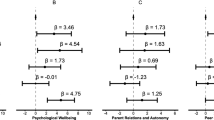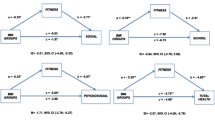Abstract
Purpose
Health-related quality of life (HRQOL) in childhood is defined as an individual’s subjective perception of the impact of health status on physical, psychological and social functioning. Nowadays, measuring of HRQOL has become an important outcome indicator in evaluating health-care. However, in younger children, the role of cardiorespiratory and other physical fitness components on HRQOL is unclear. The aims of this study were to analyse the association between components of physical fitness and HRQOL, as well as to determine which component of physical fitness was the best predictor of higher HRQOL.
Methods
This was a cross-sectional study of 1413 schoolchildren (4 to 7 years old) from Spain. HRQOL was evaluated with the KINDL-R questionnaire for parents. Cardiorespiratory fitness, muscle strength and speed-agility were assessed using the ALPHA-Fitness battery. ANCOVA models were used to assess differences in HRQOL across physical fitness categories, controlling for age and BMI, by gender. Multiple linear regression was used to determine the independent association between the different physical fitness components and HRQOL.
Results
Children with high physical fitness levels had better scores in physical well-being, school and total HRQOL score than those who had low physical fitness levels. The best predictor of HRQOL (total score) was muscular strength in boys and speed-agility among girls.
Conclusions
Children with high physical fitness levels have higher HRQOL, although the association between components of physical fitness and HRQOL varies according to gender. Improving physical fitness could be a good strategy for improving HRQOL in children.
Similar content being viewed by others
References
Gaspar, T., Ribeiro, J. P., de Matos, M. G., Leal, I., & Ferreira, A. (2012). Health-related quality of life in children and adolescents: Subjective well being. The Spanish journal of psychology, 15(01), 177–186. https://doi.org/10.5209/rev_SJOP.2012.v15.n1.37306.
Whoqol Group. (1995). The World Health Organization quality of life assessment (WHOQOL): Position paper from the World Health Organization. Social Science & Medicine, 41(10), 1403–1409. https://doi.org/10.1016/0277-9536(95)00112-K.
Solans, M., Pane, S., Estrada, M.-D., Serra-Sutton, V., Berra, S., Herdman, M., … Rajmil, L. (2008). Health-related quality of life measurement in children and adolescents: A systematic review of generic and disease-specific instruments. Value in Health, 11(4), 742–764. https://doi.org/10.1111/j.1524-4733.2007.00293.x.
Ravens-Sieberer, U., Erhart, M., Wille, N., Wetzel, R., Nickel, J., & Bullinger, M. (2006). Generic Health-related quality-of-life assessment in children and adolescents. PharmacoEconomics, 24(12), 1199–1220. https://doi.org/10.2165/00019053-200624120-00005.
Ruiz, J. R., España, V., Castro, J., Artero, E. G., Ortega, F. B., García, M., … Castillo, M. J. (2011). Alpha-fitness test battery: Health-related field-based fitness tests assessment in children and adolescents. Nutrición Hospitalaria, 26(6), 1210–1215. https://doi.org/10.3305/nh.2011.26.6.5270.
Biddle, S. J. H., & Asare, M. (2011). Physical activity and mental health in children and adolescents: A review of reviews. British Journal of Sports Medicine, 45(11), 886–895. https://doi.org/10.1136/bjsports-2011-090185.
Janz, K. F., Dawson, J. D., & Mahoney, L. T. (2002). Increases in physical fitness during childhood improve cardiovascular health during adolescence: The Muscatine Study. International Journal of Sports Medicine, 23(S1), 15–21. https://doi.org/10.1055/s-2002-28456.
Ortega, F. B., Ruiz, J. R., Castillo, M. J., & Sjöström, M. (2008). Physical fitness in childhood and adolescence: A powerful marker of health. International Journal of Obesity, 32(1), 1–11. https://doi.org/10.1038/sj.ijo.0803774.
Ruiz, J. R., Castro-Piñero, J., Artero, E. G., Ortega, F. B., Sjöström, M., Suni, J., … Castillo, M. J. (2009). Predictive validity of health-related fitness in youth: A systematic review. British Journal of Sports Medicine, 43(12), 909–923. https://doi.org/10.1136/bjsm.2008.056499.
Ruiz, J. R., Ortega, F. B., Castillo, R., Martín-Matillas, M., Kwak, L., Vicente-Rodríguez, G., … Moreno, L. A. (2010). Physical Activity, fitness, weight status, and cognitive performance in adolescents. The Journal of Pediatrics, 157(6), 917–922.e5. https://doi.org/10.1016/j.jpeds.2010.06.026.
Padilla-Moledo, C., Castro-Pinero, J., Ortega, F. B., Mora, J., Marquez, S., Sjostrom, M., & Ruiz, J. R. (2012). Positive health, cardiorespiratory fitness and fatness in children and adolescents. The European Journal of Public Health, 22(1), 52–56. https://doi.org/10.1093/eurpub/ckr005.
Gerber, M., Endes, K., Brand, S., Herrmann, C., Colledge, F., Donath, L., … Zahner, L. (2017). In 6- to 8-year-old children, cardiorespiratory fitness moderates the relationship between severity of life events and health-related quality of life. Quality of Life Research, 26(3), 695–706. https://doi.org/10.1007/s11136-016-1472-6.
Lämmle, L., Woll, A., Mensink, G., & Bös, K. (2013). Distal and proximal factors of health behaviors and their associations with health in children and adolescents. International Journal of Environmental Research and Public Health, 10(7), 2944–2978. https://doi.org/10.3390/ijerph10072944.
Borras, P. A., Vidal, J., Ponseti, X., Cantallops, J., & Palou, P. (2011). Predictors of quality of life in children. Journal of Human Sport & Exercise, 6(4), 649–656. https://doi.org/10.4100/jhse.2011.64.08.
Palou, P., Vidal, J., Ponseti, X., Cantallops, J., & Borràs, P. A. (2012). Relaciones entre calidad de vida, actividad física, sedentarismo y fitness cardiorrespiratorio en niños. Revista de Psicologia del Deporte, 21(2), 393–398.
Morales, P. F., Sánchez-López, M., Moya-Martínez, P., García-Prieto, J. C., Martínez-Andrés, M., García, N. L., & Martínez-Vizcaíno, V. (2013). Health-related quality of life, obesity, and fitness in schoolchildren: The Cuenca study. Quality of Life Research, 22(7), 1515–1523. https://doi.org/10.1007/s11136-012-0282-8.
Andersen, J. R., Natvig, G. K., Aadland, E., Moe, V. F., Kolotkin, R. L., Anderssen, S. A., & Resaland, G. K. (2017). Associations between health-related quality of life, cardiorespiratory fitness, muscle strength, physical activity and waist circumference in 10-year-old children: The ASK study. Quality of Life Research, 26(12), 3421–3428. https://doi.org/10.1007/s11136-017-1634-1.
Sánchez-López, M., Pardo-Guijarro, M. J., del Campo, D. G.-D., Silva, P., Martínez-Andrés, M., Gulías-González, R., … Martínez-Vizcaíno, V. (2015). Physical activity intervention (Movi-Kids) on improving academic achievement and adiposity in preschoolers with or without attention deficit hyperactivity disorder: Study protocol for a randomized controlled trial. Trials, 16(1), 456. https://doi.org/10.1186/s13063-015-0992-7.
Rajmil, L., Serra-Sutton, V., Fernandez-Lopez, J. A., Berra, S., Aymerich, M., Cieza, A., … Ravens-Sieberer, U. (2004). Versión española del cuestionario alemán de calidad de vida relacionada con la salud en población infantil y de adolescentes: el Kindl. Anales de Pediatría, 60(6), 514–521. https://doi.org/10.1016/S1695-4033(04)78320-4.
Ravens-Sieberer, U., & Bullinger, M. (1998). Assessing health-related quality of life in chronically ill children with the German KINDL: first psychometric and content analytical results. Quality of Life Research, 7(5), 399–407. https://doi.org/10.1023/A:1008853819715.
Ravens-Sieberer, U., Ellert, U., & Erhart, M. (2007). Gesundheitsbezogene Lebensqualität von Kindern und Jugendlichen in Deutschland. [Health-related quality of life of children and adolescents in Germany. Norm data from the German Health Interview and Examination Survey (KiGGS)]. Bundesgesundheitsblatt - Gesundheitsforschung - Gesundheitsschutz, 50(5–6), 810–818. https://doi.org/10.1007/s00103-007-0244-4.
Ravens-Sieberer, U., & Bullinger, M. (2000). KINDL R English Manual. Questionnaire for Measuring Health-Related Quality of Life in Children and Adolescents Revised Version. KINDL, Germany. Retrieved from http://www.kindl.org/.
Fleiss, J. (1986). The Design and Analysis of Clinical Experiments. In J. Fleiss (Ed.), Reliability of measurement. New York: Wiley.
Cohen, J. (1988). Statistical Power Analysis for the Behavioral Sciences. Hillsdale: Lawrence Erlbaum Associates, Publishers.
Kerry, S. M., & Bland, J. M. (1998). Statistics notes: The intracluster correlation coefficient in cluster randomisation. BMJ, 316(7142), 1455–1460. https://doi.org/10.1136/bmj.316.7142.1455.
Gálvez Casas, A., Rodríguez García, P. L., García-Cantó, E., Rosa Guillamón, A., Pérez-Soto, J. J., Marcos, T., L., & Tarraga Lopez, P. (2015). Capacidad aeróbica y calidad de vida en escolares de 8 a 12 años. Clínica e Investigación en Arteriosclerosis, 27(5), 239–245. https://doi.org/10.1016/j.arteri.2015.01.001.
Marques, A., Mota, J., Gaspar, T., & de Matos, M. G. (2017). Associations between self-reported fitness and self-rated health, life-satisfaction and health-related quality of life among adolescents. Journal of Exercise Science and Fitness, 15(1), 8–11. https://doi.org/10.1016/j.jesf.2017.03.001.
Witt, Susan, D. (1997). Parental influence on childen’s socialization to gender roles. Adolescence, 32(126).
Hogg, M. A., & Vaughan, G. M. (2008). Social psychology. (4th ed.). Upper Saddle River: Prentice Hall.
Blum, R. W., Mmari, K., & Moreau, C. (2017). It begins at 10: How gender expectations shape early adolescence around the world. Journal of Adolescent Health, 61(4), S3–S4. https://doi.org/10.1016/j.jadohealth.2017.07.009.
Waddington, I., Malcolm, D., & Cobb, J. (1998). Gender Stereotyping and physical education. European Physical Education Review, 4(1), 34–46. https://doi.org/10.1177/1356336X9800400104.
Johnson, J., Christie, J., & Yawkey, T. (1999). Play and early childhood development. (2nd ed.). New York: Scott, Foresman & Co.
Moreno-Murcia, J. A., Martínez-Galindo, C., & Alonso-Villodre, N. (2006). Gender and attitudes toward the practice of physical activity and sport. RICYDE. Revista internacional de ciencias del deporte, 2(3), 20–43. https://doi.org/10.5232/ricyde2006.00302.
Wohlwend, K. E. (2012). ‘Are You Guys Girls ?’: Boys, Identity texts, and disney princess play. Journal of Early Childhood Literacy, 12(1), 3–23. https://doi.org/10.1177/1468798411416787.
Hinkley, T., Verbestel, V., Ahrens, W., Lissner, L., Molnár, D., Moreno, L. A., … De Bourdeaudhuij, I. (2014). Early childhood electronic media use as a predictor of poorer well-being. JAMA Pediatrics, 168(5), 485. https://doi.org/10.1001/jamapediatrics.2014.94.
Rank, M., Wilks, D. C., Foley, L., Jiang, Y., Langhof, H., Siegrist, M., & Halle, M. (2014). Health-related quality of life and physical activity in children and adolescents 2 years after an inpatient weight-loss program. The Journal of Pediatrics, 165(4), 732–737.e2. https://doi.org/10.1016/j.jpeds.2014.05.045.
Cadenas-Sánchez, C., Alcántara-Moral, F., Sánchez-Delgado, G., Mora-González, J., Martínez-Téllez, B., Herrador-Colmenero, M., … Ortega, F. B. (2014). Assessment of cardiorespiratory fitness in preschool children: Adaptation of the 20 metres shuttle run test. Nutricion Hospitalaria, 30(6), 1333–1343. https://doi.org/10.3305/nh.2014.30.6.7859.
Bullinger, M., Brütt, A. L., Erhart, M., & Ravens-Sieberer, U. (2008). Psychometric properties of the KINDL-R questionnaire: Results of the BELLA study. European Child & Adolescent Psychiatry, 17(S1), 125–132. https://doi.org/10.1007/s00787-008-1014-z.
Author information
Authors and Affiliations
Corresponding author
Ethics declarations
Conflict of interest
The authors declare that there is no conflict of interest.
Additional information
Publisher’s Note
Springer Nature remains neutral with regard to jurisdictional claims in published maps and institutional affiliations.
Electronic supplementary material
Below is the link to the electronic supplementary material.
Rights and permissions
About this article
Cite this article
Redondo-Tébar, A., Ruíz-Hermosa, A., Martínez-Vizcaíno, V. et al. Associations between health-related quality of life and physical fitness in 4–7-year-old Spanish children: the MOVIKIDS study. Qual Life Res 28, 1751–1759 (2019). https://doi.org/10.1007/s11136-019-02136-6
Accepted:
Published:
Issue Date:
DOI: https://doi.org/10.1007/s11136-019-02136-6




